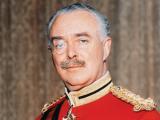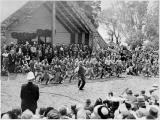William Hobson
Personal details
Full Name:
William Hobson
Lifetime:
26 Sep 1792 – 10 Sep 1842
Biography
Events In History
Auckland’s Anniversary Day commemorates the arrival of Lieutenant-Governor William Hobson in the Bay of Islands in 1840.
New Zealand became a separate colony within the British Empire. North, South and Stewart islands were to be known respectively as the provinces of New Ulster, New Munster and New Leinster.
Lieutenant-Governor William Hobson proclaimed British sovereignty over all of New Zealand – the North Island on the basis of cession through the Treaty of Waitangi, and South and Stewart Islands by right of discovery.
Articles
History of the Governor-General

New Zealand has had a governor or (from 1917) a governor-general since 1840. The work of these men and women has reflected the constitutional and political history of New Zealand in many ways. Read the full article
Page 3 - Crown colony era
New Zealand became a British colony in 1840, legitimised by the Treaty of Waitangi and Lieutenant-Governor William Hobson's 21 May declaration of
Treaty signatories and signing locations
The Treaty of Waitangi was signed on nine separate sheets by more than 500 Māori. Find out more about the sheets, the signatories and the signing locations Read the full article
Page 4 - Making the Treaty of Waitangi
New Zealand's founding document, the Treaty of Waitangi, was prepared over just a few days in February 1840. Several versions of the treaty were taken around the country for
Page 5 - Signing the treaty
By the end of 1840 about 540 Māori, including 13 women, had signed the Treaty of Waitangi; all but 39 signed the Māori text. While some had clear expectations about what their
Page 6 - Preserving the documents
The Treaty of Waitangi is currently on display in the He Tohu exhibition at the National Library of New Zealand in Wellington. It has not always been so secure. Water, time and
Taming the frontier

In 1832 James Busby was appointed as the official British Resident to New Zealand. After arriving in the Bay of Islands in May 1833 he took steps to tame what he saw as a chaotic frontier society. Read the full article
Page 5 - A separate Crown colony
Protecting Māori, regulating land purchases, controlling the activities of settlers and dealing with the potential influx of migrants underpinned British policy in 1839. New
Treaty timeline

See some of the key events between 1800 and 1849 relating to the Treaty of Waitangi. Read the full article
Page 1 - Treaty events 1800-49
See some of the key events between 1800 and 1849 relating to the Treaty of Waitangi.
The Treaty in brief
The Treaty of Waitangi is New Zealand’s founding document. It takes its name from the place in the Bay of Islands where it was first signed, on 6 February 1840. The Treaty is an agreement, in Māori and English, that was made between the British Crown and about 540 Māori rangatira (chiefs). Read the full article
Page 1 - The Treaty in brief
The Treaty of Waitangi is New Zealand’s founding document. It takes its name from the place in the Bay of Islands where it was first signed, on 6 February 1840. The Treaty is an





